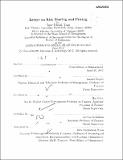Essays on Risk Sharing and Pricing
Author(s)
Tran, Ngoc-Khanh
DownloadFull printable version (15.25Mb)
Other Contributors
Sloan School of Management.
Advisor
Leonid Kogan, Hui Chen, and Adrien Verdelhan.
Terms of use
Metadata
Show full item recordAbstract
This thesis consists of three chapters in asset pricing. Chapter 1 considers an international asset pricing setting with traded and non-traded out puts. It shows that output fluctuations in nontraded industries are a central risk factor driving asset prices in all countries. This is because nontraded industries entail a growth risk that is mostly non-diversifiable, and constitute the largest component of gross domestic product (GDP) of a country. Supportive empirical evidences include; (i) the effect of an industry's growth volatility on the interest rate increases significantly with its non-tradability and (ii) carry trade strategies employing currency portfolios sorted on nontraded output growth volatility earns a sizable mean return and Sharpe ratio for US investors. Chapter 2 considers heterogeneous-agent setting in which agents differ in risk preference, time preference and/or expectations. It shows that, because of equilibrium risk sharing, the precautionary savings motive in the aggregate can vastly exceed that of even the most prudent actual agent in the economy. Consequently, a low real interest rate, resulting from large aggregate savings, can prevail with reasonable risk aversions for all agents. However, as savings rates become extremely sensitive to output fluctuation when savings motive is large, tie same mechanism that produces realistically low interest rates tends to make them unrealistically volatile. A powerful isomorphism allows differences in time preference and expectations to be swept away in the analysis, yielding an equivalent economy whose agents differ merely in risk aversion. Chapter 3 considers a novel tractable and structural pricing framework. It shows that any risk-neutral statistical distribution of state variables can be consistently tied to the economic contents of the underlying pricing model. It establishes this structural linkage by requiring that the economy's stochastic discount factor (SDF) be a proper but unspecified function of the state variables. Consequently, the structural content of the economy as characterized by the SDF can he determined from state variables dynamics through a simple linear differential equation. As a result, state variables' distribution in physical measure can also be recovered,
Description
Thesis (Ph. D.)--Massachusetts Institute of Technology, Sloan School of Management, 2012. Cataloged from PDF version of thesis. Includes bibliographical references.
Date issued
2012Department
Sloan School of ManagementPublisher
Massachusetts Institute of Technology
Keywords
Sloan School of Management.